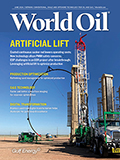Issue: June 2024
SPECIAL FOCUS: ARTIFICIAL LIFT
Thick, durable barrier coatings protect continuous rod from mechanical and corrosion damage, reducing rod fatigue failures, associated downtime, and operating costs.
Operators that rule out powerful permanent magnet motors for artificial lift operations are constraining environmental and efficiency gains.
Artificial lift technologies, including rod lift systems, remain vital to allowing companies to maximize the ROI of older assets. Deeper, more complex, mature wells incur greater wear and tear, and upgrading rod rotators allows companies to extend rod lift systems’ operational life, minimize NPT and overall costs, and optimize production.
A special project explains the symptoms of each cause of ESP failure to determine ways to improve OPEX by tracking ESP failures, ranging from 90 days up to 900 days. It performs a detailed dismantle-and-failure analysis (DIFA), combining reservoir data, tear-down information, and sampling composition analysis, triggered evidence and patterns previously not identified.
Features
Over the past decade, FourPhase has gathered solids management data from more than 150,000 hrs of operation. Vast amounts of data yield completely new perspectives. Rather than viewing sand production as a challenge, we recognize its positive aspects in reservoir management. Producing sand can be positive for your well, if done in a controlled manner.
Part 2: Erosion, due to entrained sand, is a growing problem, and existing technologies have limitations, but new solutions are available to address this issue.
Traditionally, barrier testing and subsequent validation by a technical authority can sometimes rely on personal observations and subjectivity. HydraWell looks to strike a successful balance of its values while pushing boundaries and inventing pioneering technologies that will transform well integrity management operations around the world.
This article discusses the significance of nodal technology for geophysical data acquisition in the oil and gas industry, and STRYDE’s participation in the world’s largest nodal survey in the Middle East.
While the natural gas market faces challenges like oversupply and political barriers to exporting, the upstream sector presents unique investment opportunities by taking a fresh perspective that considers evolving global +demand, regional dynamics, ESG factors, and unlocking value through strategic adaptation and informed decision-making.
Columns
Postcards from Calgary
There is more about oolitic aragonite than one might imagine
Update on the ASEAN offshore E&P threat picture: Temperature rising
Addressing hydrogen hurdles to unlock net zero potential



